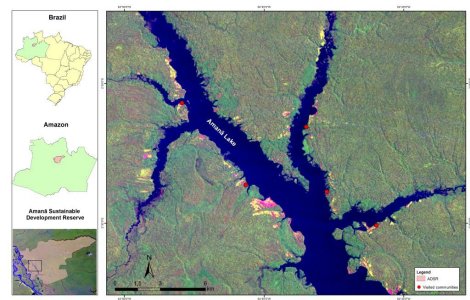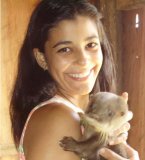IUCN/SSC Otter Specialist Group Bulletin

|
©IUCN/SCC Otter Specialist Group Citation: Fonseca, V. and Marmontel, M. (2011) Local Knowledge and Conflicts With Otters in Western Brazilian Amazon: A Preliminary Report. Proceedings of XIth International Otter Colloquium, IUCN Otter Spec. Group Bull. 28B: 64 - 68 Local Knowledge and Conflicts With Otters in Western Brazilian Amazon: A Preliminary Report Vania Fonseca1 and Miriam Marmontel1
1Grupo de Pesquisa em Mamíferos Aquáticos Amazônicos- Instituto de Desenvolvimento Sustentável Mamirauá. Tefé, Amazonas, Brazil
Email: vania@mamiraua.org.br |
| (Received 27th March 2012, accepted 17th April 2012) |
|
Abstract: Traditional knowledge constitutes an alternative source of information on animal biology and ecology. This is especially important when research projects are undertaken in collaboration with local populations living in the area of interest. In this study we aimed to characterize and summarize ethnobiological information on two species: the Neotropical otter (Lontra longicaudis,) and the Giant otter (Pteronura brasiliensis), and assess their possible interactions with fishing activities in the Amanã Sustainable Development Reserve, Western Brazilian Amazon. Five traditional communities were visited each month since December 2010 during an ongoing investigation of otter-fisheries conflicts. Anecdotal information obtained is presented concerning otter classification, behavior, and interaction of otters with fishing. |
| Keywords: otters, Lontra longicaudis, Pteronura brasiliensis, conflict, threats, fishing, conservation |
| Française | Español |
INTRODUCTION
The giant otter (GO - Pteronura brasiliensis) is the largest otter species, endemic to South America and currently considered endangered ( Duplaix et al., 2008 ). After a decline in the last decades of the 20th century, populations started to recover in some areas; in 2003 the species was confirmed to be re-occupying watercourses around Lake Amanã, Amanã Sustainable Development Reserve (ASDR), Brazil ( Marmontel et al., 2004 ). The other otter species occurring in the same area, the Neotropical otter (NO - Lontra longicaudis) has yet to be studied in the ASDR and, in general, little is known about its ecology and habits. NO is currently listed as “Data Deficient” ( Waldemarin and Alvarez, 2008 ).
Traditional knowledge has been increasingly valued and used in scientific work ( Drew, 2005 ); it constitutes an alternative source of information on animal biology and ecology ( Begossi et al., 2002 ; Gilchrist et al., 2005 ). This is especially important when research projects are undertaken in collaboration with local populations, because appreciation and respect for their cultures and knowledge also facilitates their participation on the decision-making processes. In turn, management and conservation practices can become more community-based and participatory ( Ellis, 2005 ; Oliveira et al., 2008 ).
In this study, we aim to characterize and summarize local knowledge on two otter species and to assess interactions and conflicts with people, particularly with fishing activities. Understanding local peoples’ perceptions and attitudes towards otters can help provide a basis for identifying threats, and plan conflict mitigation and conservation management strategies.
STUDY AREA AND METHODS
The study area is located inside the Amanã Sustainable Development Reserve, comprising the upper Amanã Lake and associated watercourses ( Figure 1 ), where around 400 people live in communities and isolated dwellings (IDSM - 2006 population census). Agriculture is the main economic activity, including the cultivation of manioc, banana, avocado, açaí and other products. The ASDR is one of the largest protected areas of the Amazon. By Brazilian law, sustainable development reserves are protected areas where natural resources can be exploited by traditional resident populations in a sustainable way.
 |
| Figure 1: Study Area |
Five traditional riverine communities have been regularly visited since December 2010, and anecdotal information collected based on informal conversations with local inhabitants during monthly field visits of an ongoing project on giant otter-fisheries conflicts. Participant observation is being used to obtain preliminary information and to familiarize researchers with the residents. As a first approach, priority is being given to information obtained from men who are householders, since in most cases they assume most tasks of fishing and hunting, and are therefore more likely to observe otters and other aquatic animals. We also have a collaborative field work approach ( Huntington, 2000 ) where all field assistants are local residents and contribute information. Attention was given to maintaining an open and flexible dialogue, avoiding induction of answers or interviewer influence on statements of observers.
Classification of otters
GOs are commonly known in the area as ariranhas, the most common name used in Brazil. This is described as the largest kind of otter. Three other local names/kinds of otters were recognized: lontrinha, mucurinha or mucura d’água, and meiona. Lontrinha, according to descriptions, is the typical NO, occurring in all kinds of aquatic habitats (lakes, flooded forests and watercourses). Some people also call it mucurinha or mucura d’água (which can be translated as “small opossum” or “small water opossum”), and in this case it is described as the smallest kind of otter, with an intense black fur, occurring in the main channel of watercourses. Meiona is the third name, given for an otter described as large, with an intermediate size between a mucurinha or lontrinha and an ariranha; it can have smooth creamy stripes coming from each side of the chin to the throat and a reddish pattern on the throat. The latter two names probably describe intraspecific size and color variations of NO individuals.
Behaviour
GOs are perceived as rowdy, intrepid and noisy animals (some people describe their vocalizations as similar to a crying child), that live in large groups (“bandos”) of up to 15 animals and can swim “faster than fish”. It is commonly believed that their communal latrines are places where they eat (locally known as comedias), due to the fish remains found in these marking places. The large quantity of scales and fish bones in the latrines is thus associated with an intensely predatory GO behavior.
NOs are more elusive animals, and usually only single individuals are observed for a short time. Only one person interviewed considered NOs less shy and more visible than GOs.
Regarding activity rhythms, both otter species are seen as diurnal, and no nocturnal activity was ever seen by people interviewed. In one exceptional case, two men paddling in a canoe directly in front of a GO den at night, heard an alarm vocalization by an animal inside, but this was probably due to the disturbance by human proximity.
Both species are observed more during the dry season than the wet season, when otters are said to spend most of their time inside flooded forests (igapós), due to the higher availability of fish there relative to the main watercourses. Nonetheless, there are exceptions, since several small watercourses only have a substantial water flow during the wet season, so that isolated human dwellings next to these watercourses enable more otter sightings during the wet season.
Utilization and conflicts
Both species are said to have had a high economic importance in the past. Together with jaguar (Panthera onca) and puma (Puma concolor) skins, otters skins were the most valuable in the market. Since the prohibition of the fur trade in the last century, otters are not hunted for their pelts. There was one narration of a medicinal use of NO’s skin, as an infusion, to heal asthma and shortness of breath. Consumption of otter meat is not practiced in the area.
GOs are currently perceived, especially by younger householders, as a menace for the fishing activity, mainly for gillnet damage and secondarily for the depletion of fishery resources. In December 2010, we documented one case of intentional killing by firearm of a young GO, and we obtained narratives of some householders who state they will shoot GOs if they continue to damage fishing gear, even though the same people see them as charismatic and beautiful animals. Most of the damage caused by GOs occurs during the wet season, suggesting a seasonal pattern of conflicts in the study area. Some locals fear and avoid GO groups, believing that they could get inside their boats to attack.
NOs are not usually mentioned in the conflict context; thus far we have heard only one resident’s declaration that NOs occasionally destroy fishing gillnets.
DISCUSSION
Information obtained with from local residents of the Amanã Sustainable Development Reserve reveal that they have basic ethnobiological knowledge of both species, describing several aspects of their ecology and behavior, mostly consistent with our scientific understanding. Nevertheless, it is possible to identify a need for environmental education and awareness activities, since some misconceptions are identified, especially in GO behavior (e.g. the nature of latrines).
Conflictual interactions between people and wild animals will influence the future survival of species ( Nyahongo and Røskaft, 2011 ), including otters. Local residents can threaten species survival through persecution, retaliatory killing and hunting. In the ASDR, the main cause for conflict appears to be the perception of damage caused by giant otters to gillnets, together with a perception of prey depletion. We highlight the need for studies that accomplish these interactions. Such studies should attempt to address whether the perceptions of local residents are supported by actual otter damage to fishing apparel. If this damage can be identified as a relevant negative influence of otters on fishing, further conflict mitigation measures might be needed.
ACKNOWLEDGMENTS - We thank Ministério da Ciência e Tecnologia for funding and V. Fonseca’s research fellowship, and the Mamirauá Institute for providing logistical and administrative support for field and office work. We are thankful to all the people from Amanã Lake who kindly collaborate with our research and José Raimundo Reis, who provided assistance in field work.
REFERENCES
Begossi, A., Hanazaki, N., Silvano, R.A.M. (2002). Ecologia Humana, Etnoecologia e Conservação. In: Amorozo, M. C. M. et al. (Eds.) Métodos de Coleta e Análise de dados em Etnobiologia, Etnoecologia e Disciplinas Correlatas. UNESP/CNPQ, Rio Claro, Brazil, pp 93-128.
Drew, J.A. (2005). Use of Traditional Ecological Knowledge in Marine Conservation. Conservation Biology
19 (4):
1286–1293.
Duplaix, N., Waldemarin, H.F., Groenendijk, J., Evangelista, E., Muanis, M., Velasco, M., Botello, J.C. (2008). Pteronura brasiliensis. In: IUCN 2010. IUCN Red List of Threatened Species. Version 2010.3. <
www.iucnredlist.org
>.
Ellis, S.C. (2005). Meaningful Consideration? A Review of Traditional Knowledge in Environmental Decision Making. Arctic 58
(1): 66-77.
Gilchrist, G., Mallory, M, Merkel, F. (2005). Can Local Ecological Knowledge Contribute to Wildlife Management? Case Studies of Migratory Birds. Ecology and Society 10(1): 20.
Huntington, H.P. (2000). Using Traditional Ecological Knowledge in Science: Methods and Applications. Ecological Applications
10 (5): 1270-1274.
Marmontel, M., Calvimontes, J., Carvalho Jr, O., Wegner, E. (2004). Ariranhas (Pteronura brasiliensis) na Reserva de Desenvolvimento Sustentável Amanã (RDSA): Boas e más notícias para uma espécie ameaçada de extinção. In: I Seminário Anual de Pesquisas IDSM - Livro de Resumos.
Nyahongo, J.W., Røskaft, E. (2011). Perception of people towards lions and other wildlife killing humans, around Selous Game Reserve, Tanzania. International Journal of Biodiversity and Conservation 3 (4): 110-115.
Oliveira, F., Beccato, M.A.B., Nordi, N., Monteiro-Filho, E.L.A. (2008). Etnobiologia: Interfaces entre os Conhecimentos Tradicional e Científico. In: Monteiro-Filho, E.L.A., Monteiro, K.D.K.A. (Orgs.) Biologia, Ecologia e Conservação do Boto-Cinza. IPeC - Páginas e Letras, São Paulo, Brazil, pp. 233-261.
Waldemarin, H.F., Alvarez, R. (2008). Lontra longicaudis. In: IUCN 2011. IUCN Red List of Threatened Species. Version 2011.1. <
www.iucnredlist.org
>.
Résumé : Savoirs Locaux et Conflits avec les Loutres En Amazonie de l’Ouest du Bresil: Rapport Preliminaire
Les savoirs traditionnels constituent une source alternative d'informations sur la biologie animale et l'écologie. Ceci est particulièrement important lorsque les projets de recherche sont entrepris en collaboration avec les populations locales vivant dans la zone d'intérêt. Dans cette étude nous avons cherché à caractériser et résumer les informations ethnobiologiques de deux espèces: la Loutre à longue queue (Lontra longicaudis) et la Loutre géante (Pteronura brasiliensis), et d'évaluer leurs possibles interactions avec les activités de pêche dans la Réserve d'Amana, à l'Ouest de l’Amazonie brésilienne. Chaque mois depuis décembre 2010, cinq communautés traditionnelles ont été visitées dans le cadre d'une enquête sur les conflits entre loutres et pêche. Des informations sur la classification, le comportement et l'interaction des loutres avec la pêche sont présentés ici.
Revenez au dessus
Resumen: Conocimiento Local y Conflictos Con Nutrias en la Amazonía Occidental Brasilera: Informe Preliminar
El conocimiento tradicional constituye una fuente alternativa de información sobre la biología y ecología animal. Esto es especialmente importante cuando se llevan a cabo proyectos de investigación en colaboración con las poblaciones locales que viven en el área de interés. En este estudio hemos caracterizado y compilado la informacion etnobiológica sobre dos especies: la nutria Neotropical (Lontra longicaudis ) y la nutria Gigante (Pteronura brasiliensis), y hemos evaluado sus posibles interacciones con las actividades de pesca en la Reserva de Desarrollo Sostenible Amanã, en la Amazonía Occidental Brasilera. Desde Diciembre de 2010, fueron visitadas mensualmente cinco comunidades tradicionales, durante una investigación en desarrollo sobre los conflictos nutrias-pesca. Se presenta la información anecdótica obtenida, concerniente a clasificación y comportamiento de las nutrias, e interacción de las nutrias con la pesca.
Vuelva a la tapa

